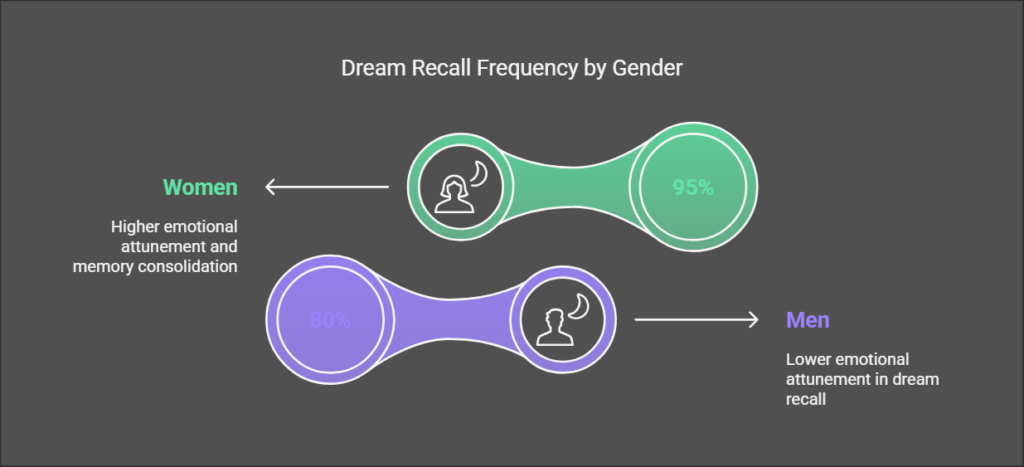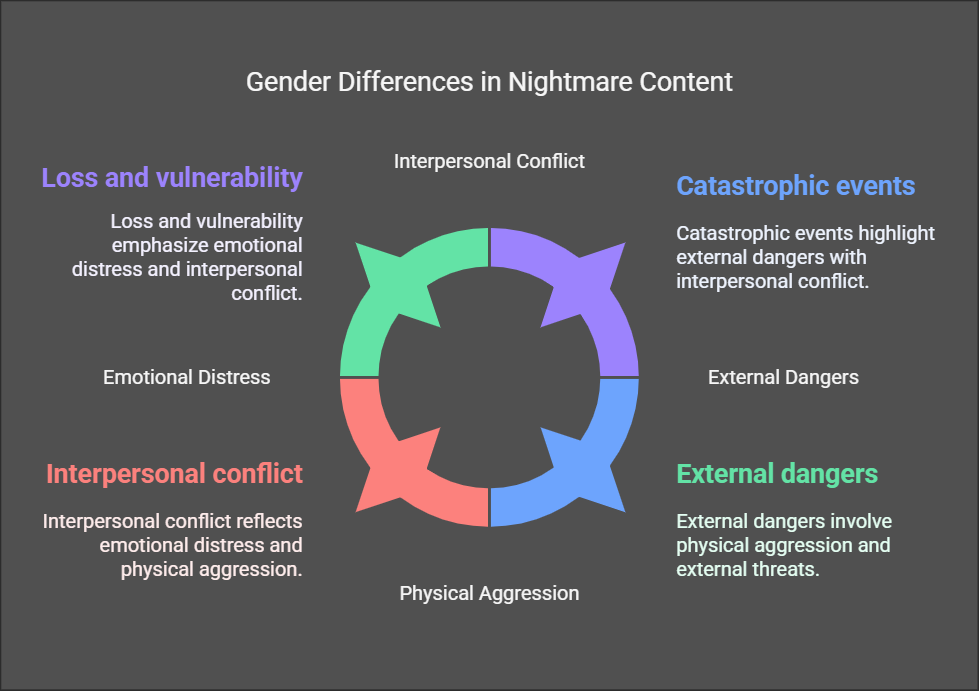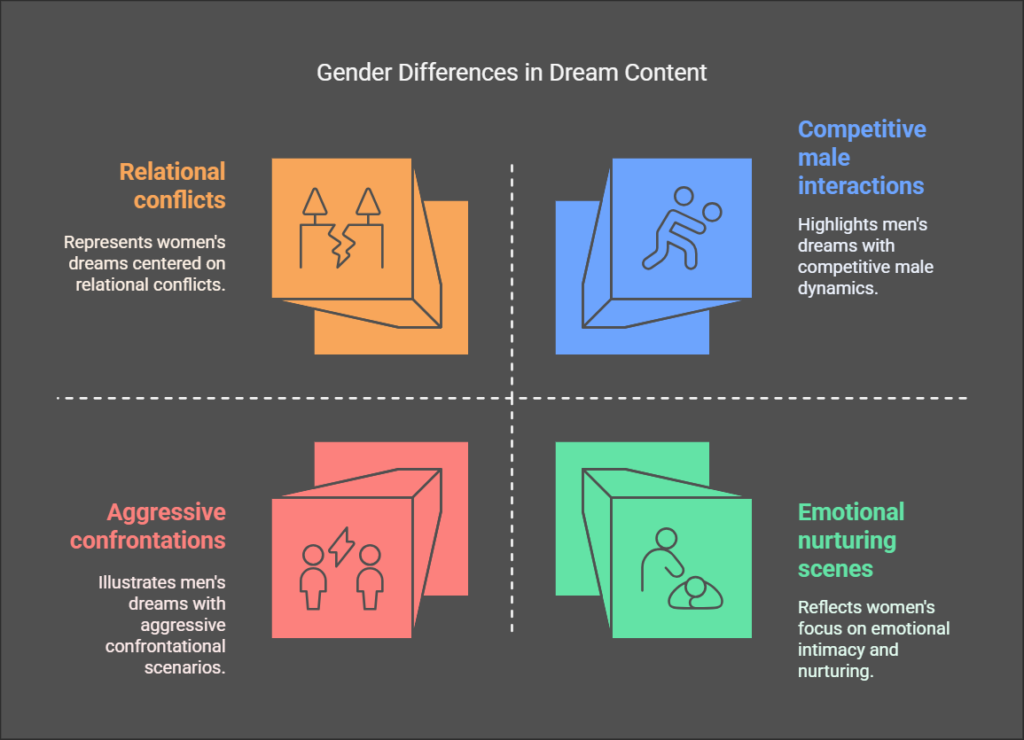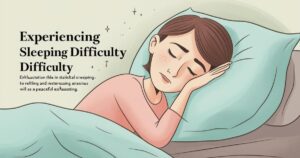Recent research confirms that while everyone dreams, the content and recall of these dreams differ markedly between the genders. Women generally report more frequent and emotionally vivid dreams, while men tend to experience dreams with higher levels of aggression and sexual imagery.

These differences aren’t just curiosities—they reflect underlying variations in emotional processing, societal roles, and even personality traits.
Key Takeaways
- Enhanced Dream Recall: Women typically recall dreams more frequently—with studies noting recall rates of up to 95% when awakened during REM sleep compared to about 80% for men.
- Nightmare Variations: Women experience more frequent and emotionally intense nightmares centered on interpersonal conflict, while men’s nightmares often emphasize physical aggression and external threats.
- Content and Themes: Men’s dreams more commonly include aggressive and sexual content, whereas women’s dreams are richer in interpersonal relationships and social dynamics.
- Influence of Waking Life: The continuity hypothesis explains that our dreams mirror our daily experiences and societal expectations, highlighting the influence of gender roles on dream content.
The Landscape of Dream Recall
Studies consistently show that women recall their dreams more frequently and in greater detail than men. One survey found that when abruptly awakened during REM sleep, up to 95% of women can recount their dream storyline, compared to around 80% of men.

Researchers attribute this disparity to differences in emotional attunement and possibly even biological factors that enhance memory consolidation in women.
Nightmare Frequency and Intensity
Nightmares also reveal a clear gender divide. Women not only experience nightmares more often, but the content is typically laden with deep emotional distress—focusing on themes like loss, interpersonal conflict, and vulnerability.
In contrast, men’s nightmares frequently involve themes of physical aggression, catastrophic events, or external dangers. These variations likely stem from distinct societal pressures and inherent fears encountered in waking life.

Dream Content and Themes
When analyzing dream content, several intriguing patterns emerge:
Get instant dream insights with our Free Dream Interpretation App
- Character Focus: Men’s dreams tend to feature predominantly male characters and often revolve around competitive or aggressive interactions. Women, however, report dreaming about both genders equally, reflecting a focus on relational and social connections.
- Aggression vs. Intimacy: Men’s dreams are statistically more likely to contain aggressive or sexually charged scenarios, whereas women’s dreams are more centered on emotional intimacy and nurturing interactions.

These differences not only echo our distinct waking experiences but also underline how cultural norms and gender expectations shape our subconscious narratives.
Dream Sharing and Social Connection
Women are generally more inclined to share and discuss their dreams than men—a behavior that fosters deeper emotional bonds and support networks. This tendency reflects broader socialization patterns where women are encouraged to express and process emotions openly. Conversely, men might refrain from discussing dreams due to cultural pressures favoring stoicism and self-reliance.
Influences from Personality and Waking Life
Beyond gender, personality traits such as openness to experience and neuroticism also play crucial roles in dream recall and content. People with high levels of openness may experience more vivid and imaginative dreams, while those with higher neuroticism might report more emotionally charged or distressing dream scenarios.
The continuity hypothesis further suggests that our dreams are a reflection of our daily lives, meaning that gender differences in our waking experiences naturally extend into our dream world.
Related: Dreaming of Experiments
Cultural and Societal Influences
Cultural background and societal expectations greatly influence how dreams are experienced and remembered. In many cultures, dreams are imbued with spiritual or symbolic significance, and the way men and women interpret these experiences can vary widely.
For instance, while some societies view dream sharing as a path to communal bonding, others may regard it as a private or even taboo subject. Such cultural factors contribute to the observed gender differences in both dream content and dream-sharing practices.
Implications for Therapy and Self-Discovery
Recognizing these gender-specific patterns in dreaming can enhance approaches to dream interpretation and psychotherapy. Therapists who are aware of these nuances can better help clients uncover the personal and emotional meanings behind their dreams.
This personalized insight not only aids in resolving internal conflicts but also opens a gateway to improved emotional well-being and self-understanding.
Conclusion
While both men and women engage in the universal act of dreaming, how they do so are uniquely colored by biological, psychological, and sociocultural factors. Women’s dreams are generally more detailed, emotionally rich, and frequently recalled, whereas men’s dreams are more inclined toward aggression and sexual content.




